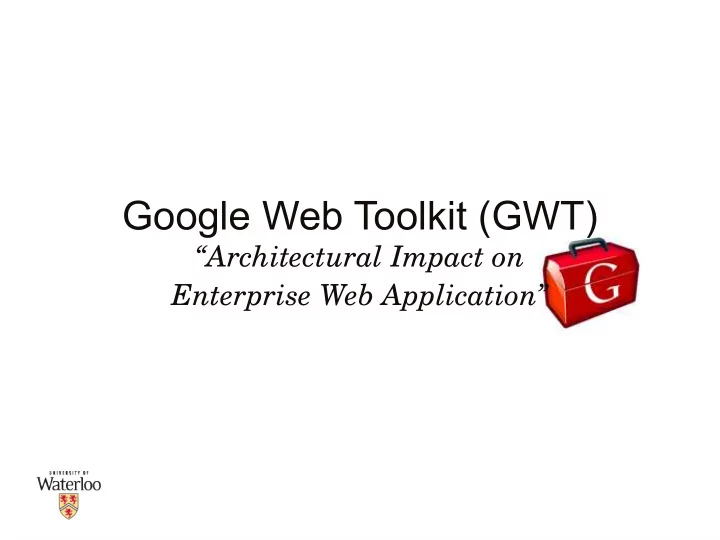

Google Web Toolkit (GWT) “Architectural Impact on Enterprise Web Application”
First Generation HTTP request (URL or Form posting) W W W HTTP response (HTML Document) Client Tier Server Tier Data Tier CGI-Scripts Data Source Web 2
First Generation Shortcomings ● lack of a coherent architectural model – adhoc scripts development – no interaction between scripts ● evolution – how do you evolve scripts? – written in different languages ● data/information sharing – has to be via an external repository – difficult to control transactions 3
First Generation Shortcomings ● security – CGI based scripts still a nightmare for admins – scripts are executed in native environment ● server execution environment is directly exposed ● vulnerabilities in server code are also exposed ● throughput – a script launches a process – so what? ● tight coupling – each view is coupled to its corresponding script 4
Second Generation W J W W J HTTP response (HTML Document) Server Tier Data Tier Client Tier Presentation JEE Container Servlet Data Services Source JDBC Web JEE Server 5
Second Generation Shortcomings ● server focused – most improvements are realized on the server side ● client tier – still based on primitives ● HTML, javascript, CSS etc. – not dynamic ● request-response cycle – worse than first generation ??? 6
GWT What is GWT SG + AJAX = GWT Not Exactly 7
GWT GWT is a lot more than that ● a paradigm shift away from – web application building blocks – synchronous communication ● built on standards – integrates well ● with existing server applications, web services – composite building blocks ● HTML, javascript etc are low-level primitives ● separation of concerns 8
GWT Components Core Browser Runtime Environment Java-JS JRE RPC widgets JSNI Compiler Emulator manager RPC XML/JSON Browser GWT Integration Servlet Ext i18N 9
Java-JS Compiler Converts Java to Javascript ● src-to-src compiler ● high level typed language to a script language – does this make sense??? ● JS code optimization – browser engines – size – security / obfuscation – localization 10
JRE Emulator Emulates ● core Java classes in Javascript Composite building blocks ● allows for building composite building blocks ● client tier built on – composite building blocks ● rather than low level primitives 11
JSNI Java Script Native Interface ● wrapper – for Javascript inside Java code ● extension point – for integration with non GWT client components 12
RPC Remote Procedure Call ● replaces HTTP RPC- getId() – for communication after app boot t 0 ● asynchronous – why? RPC- getName() t 1 – breaks the request-response cycle getName() t 2 ● supports various protocols getId() t 3 – Ajax, JSON, GWT Time 13
Servlet Extension Extension of JEE Servlet ● integration with older JEE application – get all the JEE benefits for free ● server component – facade for business functionality ● evolution – highly flexible 14
GWT Components Core Browser Runtime Environment Java-JS JRE RPC widgets JSNI Compiler Emulator manager RPC XML/JSON Browser GWT Integration Servlet Ext i18N 15
Impact Scalability Reusability Interoperability Design by contract Evolution Java based development 16
Scalability Improvement in server performance ● (near) stateless servers – client tier components truly reside in client tier – previously ● the state was maintained on the presentation tier ● the view was rendered on the client tier ● optimized communication strategy – via aggregation of control/data exchange – decrease in server load – better bandwidth usage 17
Reusability Application ● single code base to support – multiple browser engines – internationalization ● i18N versions of the applications ● application broken over reusable modules Design & development ● OOD – what benefits do we get from OOD? 18
Interoperability Integration / Extension points ● Javascript native interface (JSNI) – a layer of abstraction for integrating Javascript ● third party & legacy Javascript libraries ● server side integration – servlet extension ● plugs into the JEE platform ● also possible for other platforms – mashups ● use of diverse web services 19
Design by Contract Client tier standardization ● browser runtime environment (BRE) – client code has to abide by the BRE interface – same enhancement that JEE brought to server tier – isn't that strong coupling between GWT and an application client code? ● preserves the architectural integrity 20
Evolution Organic growth ● OOA & OOD – what does this buy us? – OO Javascript Rich Internet Applications (RIA) ● HTML & HTTP as the basic building primitive ● prevails where others failed – Java applet, ActiveX, Adobe flex 21
Java based Development Testing & Tools ● well established frameworks for – testing & profiling ● continuous integration ● well supported tools – IDEs, profilers etc. ● skills-set standardization – development teams 22
Recommend
More recommend